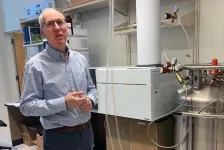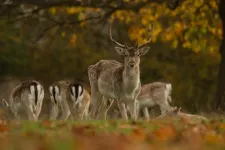(Press-News.org) UNIVERSITY PARK, Pa. — Pumpkin toadlets are in trouble. Progressively severe droughts are disrupting the microbiomes of the thumbnail-sized orange frogs, potentially leaving them vulnerable to a deadly fungal disease, according to a new study by an international research team. The finding suggests that abnormal rainfall patterns, which are expected to worsen due to climate change and deforestation, may upset mutually beneficial relationships between wildlife and microorganisms, leading to biodiversity decline.
The researchers, led by Penn State doctoral candidate Shannon Buttimer and Professor of Biology Guilherme Becker, published their findings in Ecology Letters. The work was featured on the cover of the journal’s January issue.
During a campaign to sample the skin bacteria of the pumpkin toadlets for his master’s thesis, co-author Diego Moura-Campos found nine dead or dying frogs. It was later confirmed that they had died of chytridiomycosis, a fungal disease caused by Batrachochytrium dendrobatidis (Bd), which is a threat to amphibian populations worldwide. Pumpkin toadlets, like many other amphibians, boast natural Bd-inhibiting bacteria on their skin. These microbes should help protect against the fungus, so why did these frogs die, and why all at once?
“It is super rare to witness amphibian die-offs in the wild, let alone have collected samples from before and throughout an outbreak,” said Buttimer, who is pursuing her doctorate in the Huck Institutes of the Life Sciences’ Intercollege Graduate Degree Program in Ecology. Buttimer explained that deforestation of this region and in the Amazon rainforest has resulted in greater rainfall variability — increased duration of drought and, conversely, heavier periods of rainfall. “The outbreak coincided with some of the lowest rainfall in the area in the past 60 years, so we set out to investigate whether there might be a connection between the drought, the skin microbiome, and the die-off."
Using 237 skin swab samples gathered over the course of a year, the researchers genetically sequenced the toadlets’ skin microbiomes and compared that information against a reference database of skin microbes identified as Bd-inhibitors — bacteria that exert a protective effect against the amphibian chytrid fungus. The Amphibac database, organized by Doug Woodhams, assistant professor of biology at the University of Massachusetts, Boston and 25 co-authors, contains a growing list of DNA sequences of microbes whose inhibitory properties have been tested against Bd in controlled lab experiments.
The researchers found that toadlet microbiomes sampled following periods of higher-than-average rainfall were more abundant in known Bd-inhibitors. In contrast, one month after the drought, the toadlet microbiomes had fewer known Bd-inhibiting bacteria. The finding, researchers said, indicates that drought may reduce the abundance of some Bd-inhibiting bacteria, leaving the toadlets vulnerable to the fungal disease.
The researchers also investigated microbiome diversity metrics like species richness and composition. Overall, the researchers found that higher levels of species richness were associated with lower infection severity. Microbiome composition also became more variable following periods of low rainfall, indicating that the toadlets’ microbiomes may have transitioned to a state known as dysbiosis, where they become less stable and less functional. According to researchers, this higher variability and the loss of key protective microbes may both contribute to the increase in chytridiomycosis infections.
While further experimentation is required to understand the causal mechanisms that influence the skin microbiome and Bd dynamics, the researchers said this study underscores the importance of considering microbiome health when assessing populations that are threatened by climate change, habitat loss and disease.
“I hope our results will encourage people to consider how deforestation and climate change are breaking down invisible symbioses and leading to population-scale consequences,” Buttimer said.
Co-authors on the study include Diego Moura-Campos, The Australian National University; Sasha E. Greenspan, Wesley J. Neely, University of Alabama; Lucas Ferrante, Universidade Federal do Amazonas; Luís Felipe Toledo, Universidade Estadual de Campinas.
END
Drought may drive deadly amphibian disease, researchers find
2024-02-12
ELSE PRESS RELEASES FROM THIS DATE:
New study finds commonly used antibiotic is a cost-saving treatment for reducing maternal sepsis, death or infection in developing countries
2024-02-12
UNDER EMBARGO UNTIL: Feb. 12, 2024, 4:30 PM EST
Media Contacts: Karen Addis, APR, karen@addispr.com, +1 (301) 787-2394; Kerri Wade, MPA, kwade@smfm.org, +1 (202) 236-1780
National ...
Reshaping our understanding of granular systems
2024-02-12
Your morning cereal, a jar of nuts, the sands of distant planets, and even the concrete in your city are all examples of granular systems surrounding us. And such systems are harboring secrets that could change the way we mix things up.
In a new paper published in the journal Proceedings of the National Academy of Sciences (PNAS), scientists at the University of Rochester, including Rachel Glade, an assistant professor of earth and environmental sciences and of mechanical engineering; Fernando David Cúñez, a former postdoctoral research associate ...
Can hydrogels help mend a broken heart?
2024-02-12
You can mend a broken heart this valentine’s day now that researchers invented a new hydrogel that can be used to heal damaged heart tissue and improve cancer treatments.
University of Waterloo chemical engineering researcher Dr. Elisabeth Prince teamed up with researchers from the University of Toronto and Duke University to design the synthetic material made using cellulose nanocrystals, which are derived from wood pulp. The material is engineered to replicate the fibrous nanostructures and properties of human tissues, thereby recreating its unique biomechanical properties.
"Cancer is a diverse disease and two patients with the same type of cancer will often respond ...
New study finds that pregnancy complications can also affect child’s health later in life
2024-02-12
Hypertensive disorders of pregnancy (HDP) and gestational diabetes (GDM) are two of the most common pregnancy complications and put pregnant people at increased risk of developing cardiovascular disease later in life.
Now, in a new study to be presented today at the Society for Maternal-Fetal Medicine’s (SMFM) annual meeting, The Pregnancy Meeting™, researchers will unveil findings that suggest these pregnancy complications may also result in worse cardiovascular health for the child.
In a secondary analysis of 3,317 maternal-child pairings from the prospective Hyperglycemia ...
Scientists discover biological mechanism of hearing loss caused by loud noise – and find a way to prevent it
2024-02-12
Anyone who has ever been to a loud concert knows the feeling of ringing ears. Some people experience temporary or even permanent hearing loss or drastic changes in their perception of sound after the loud noises stop. Thanos Tzounopoulos, Ph.D., director of the Pittsburgh Hearing Research Center at the University of Pittsburgh School of Medicine has focused his scientific career on investigating how hearing works and developing ways to treat tinnitus and hearing loss.
In a paper published today in ...
Widespread machine learning methods behind ‘link prediction’ are performing very poorly
2024-02-12
As you scroll through any social media feed, you are likely to be prompted to follow or friend another person, expanding your personal network and contributing to the growth of the app itself. The person suggested to you is a result of link prediction: a widespread machine learning (ML) task that evaluates the links in a network — your friends and everyone else’s — and tries to predict what the next links will be.
Beyond being the engine that drives social media expansion, link prediction is also used in a wide range of scientific research, such as predicting the interaction between genes and proteins, and is used by researchers as a benchmark for ...
The hidden rule for flight feathers—and how it could reveal which dinosaurs could fly
2024-02-12
Birds can fly— at least, most of them can. Flightless birds like penguins and ostriches have evolved lifestyles that don’t require flight. However, there’s a lot that scientists don’t know about how the wings and feathers of flightless birds differ from their airborne cousins. In a new study in the journal PNAS, scientists examined hundreds of birds in museum collections and discovered a suite of feather characteristics that all flying birds have in common. These “rules” provide clues as to how the dinosaur ancestors of modern birds first evolved the ability to fly, ...
Machine learning promises to accelerate metabolism research
2024-02-12
A new study shows that it is possible to use machine learning and statistics to address a problem that has long hindered the field of metabolomics: large variations in the data collected at different sites.
“We don’t always know the source of the variation,” said Daniel Raftery, professor of anesthesiology and pain medicine at the University of Washington School of Medicine in Seattle. “It could be because the subjects are different with different genetics, diets and environmental exposures. Or it could be the way samples were collected and ...
Researchers uncover a key link in legume plant-bacteria symbiosis
2024-02-12
Legume plants have the unique ability to interact with nitrogen-fixing bacteria in the soil, known as rhizobia. Legumes and rhizobia engage in symbiotic relations upon nitrogen starvation, allowing the plant to thrive without the need for externally supplied nitrogen. Symbiotic nodules are formed on the root of the plant, which are readily colonized by nitrogen-fixing bacteria. The cell-surface receptor SYMRK (symbiosis receptor-like kinase) is responsible for mediating the symbiotic signal from rhizobia perception to formation of the nodule. ...
Genetic analysis and archaeological insight combine to reveal the ancient origins of the fallow deer
2024-02-12
Modern populations of fallow deer possess hidden cultural histories dating back to the Roman Empire which ought to be factored into decisions around their management and conservation.
New research, bringing together DNA analysis with archaeological insights, has revealed how fallow deer have been repeatedly moved to new territories by humans, often as a symbol of colonial power or because of ancient cultures and religions.
The results show that the animal was first introduced into Britain by the Romans ...





